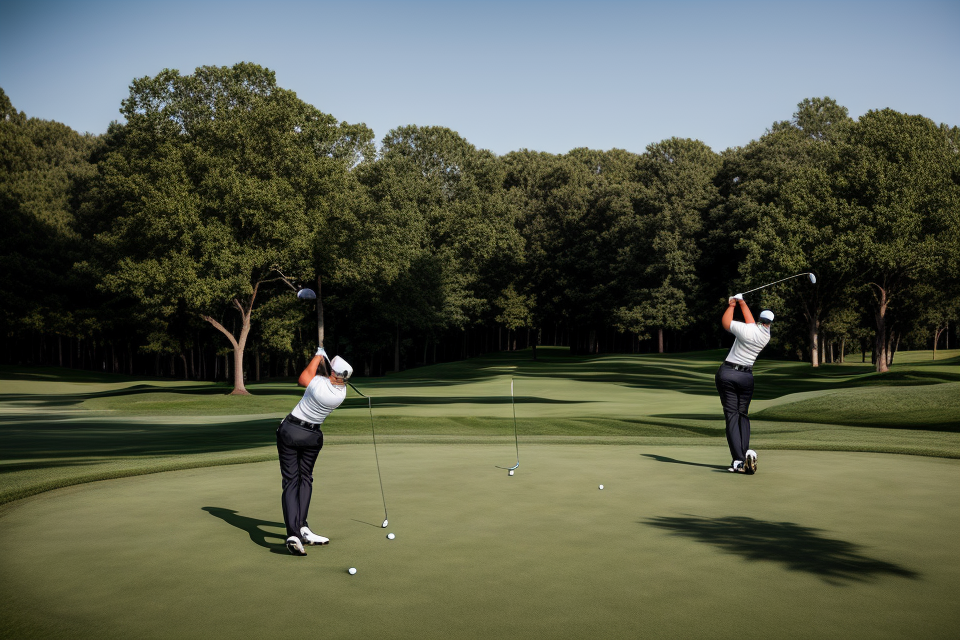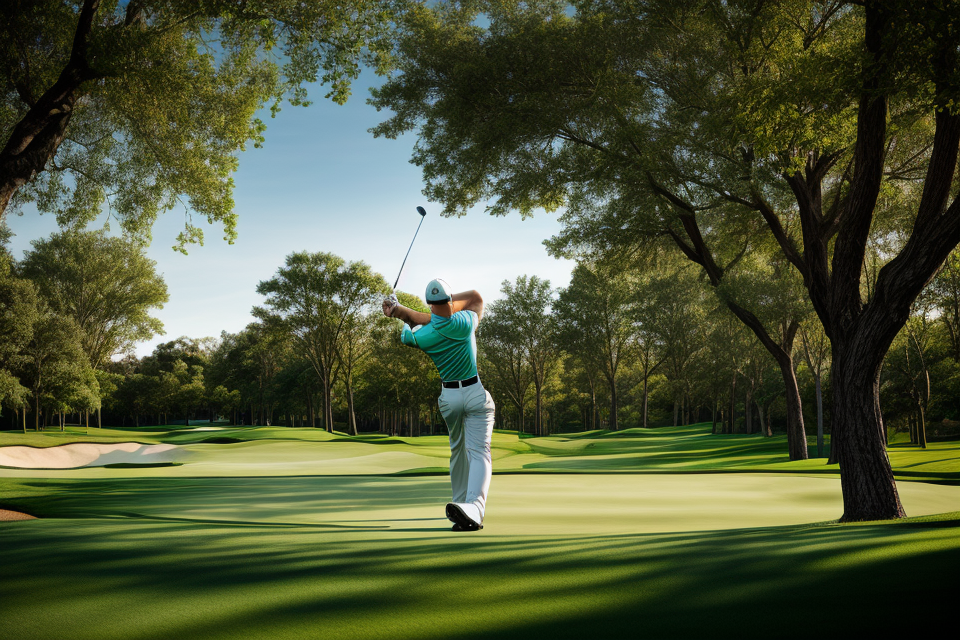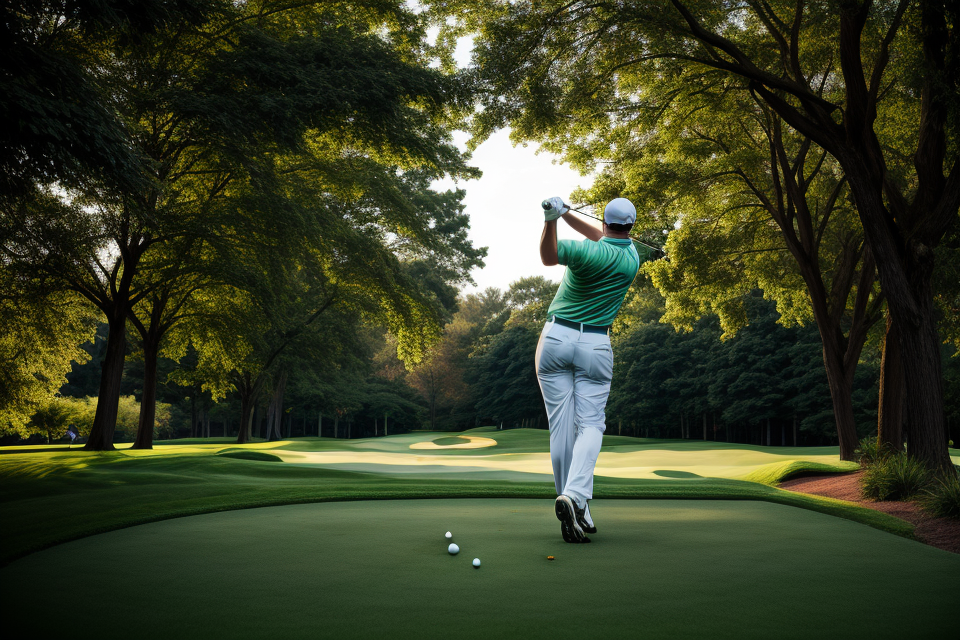
Golf is a sport that requires precision, patience, and practice. Whether you’re a beginner or an experienced golfer, there’s always room for improvement. Improving your golf skills can be a challenging task, but with the right guidance and practice, you can become a better golfer. In this comprehensive guide, we’ll explore some effective tips and techniques that can help you improve your golf game. From improving your swing to enhancing your mental game, we’ll cover everything you need to know to take your golf skills to the next level. So, let’s get started and discover how you can improve your golf skills today!
To improve your golf skills, start by practicing your grip, stance, and swing technique. Hit the driving range regularly to develop your distance and accuracy, and work on your short game to improve your proximity to the hole. Invest in quality golf equipment and focus on your physical fitness to enhance your performance. Finally, develop your mental game by practicing your focus and emotional control on the course. With dedication and hard work, you can improve your golf skills and lower your scores.
Understanding the Fundamentals
Grip
When it comes to improving your golf skills, one of the most important aspects to focus on is your grip. Your grip is the foundation of your swing, and it can have a significant impact on the accuracy and distance of your shots. In this section, we will discuss the correct grip for different golf clubs, the importance of a firm grip, and common grip mistakes to avoid.
Correct Grip for Different Golf Clubs
The grip for each golf club is slightly different, and it’s important to understand how to hold each one correctly. Here are the basic grip techniques for the most commonly used golf clubs:
- Driver: The most common grip for a driver is a “neutral” grip, where the hands are placed in line with the club’s shaft. This allows for maximum control and power.
- Fairway Woods: The grip for fairway woods is similar to that of a driver, but with the hands slightly more forward on the club.
- Hybrid: The grip for a hybrid is similar to that of a fairway wood, but with the hands placed slightly further back on the club.
- Irons: The grip for irons is more upright than the other clubs, with the hands placed closer together. This allows for more control and accuracy.
- Wedges: The grip for wedges is similar to that of irons, but with the hands placed further apart to allow for more control when chipping and pitching.
Importance of a Firm Grip
A firm grip is essential for maximizing control and power in your swing. A loose grip can lead to a loss of control and accuracy, while a grip that is too tight can lead to tension and a loss of power. To achieve a firm grip, hold the club with your fingers, rather than your palms, and keep your hands relaxed but firm.
Common Grip Mistakes to Avoid
There are several common grip mistakes that can negatively impact your swing. Here are a few to watch out for:
- Gripping the Club Too Tightly: Gripping the club too tightly can lead to tension in your hands and a loss of power. To avoid this, try to grip the club with your fingers, rather than your palms.
- Crossing Over Your Hands: Crossing over your hands can lead to inconsistent ball flight and a loss of control. To avoid this, make sure your hands are placed in a neutral position, with your right hand slightly ahead of your left.
- Lifting Your Head: Lifting your head during your swing can lead to a loss of control and accuracy. To avoid this, keep your head down and focused on the ball throughout your swing.
By paying attention to your grip and avoiding these common mistakes, you can improve your golf skills and take your game to the next level.
Stance
The Proper Golf Stance
The golf stance is the foundation of a successful swing. It is essential to establish a stable and balanced position from which to execute your shots. The proper golf stance involves the following elements:
- Feet shoulder-width apart, with the ball positioned between them
- Knees slightly bent, hips back, and weight distributed evenly on both feet
- Arms relaxed and bent at a 90-degree angle, with the club held parallel to the ground
- Club grip placed near the bottom of the handle, with the hands slightly ahead of the ball
- Eyes focused on the ball, with the head aligned over the shoulders
How to Adjust Your Stance for Different Shots
To improve your golf skills, it is crucial to understand how to adjust your stance for various shots. For example, when playing a fade shot, you may need to open your stance slightly to prevent a hook. Conversely, when playing a draw shot, you may need to close your stance to avoid a slice. Experiment with different stance configurations to find the one that works best for each shot.
The Importance of Balance and Alignment
Balance and alignment are critical components of the golf stance. Good balance ensures that you can maintain control throughout the swing, while proper alignment helps you aim accurately and hit the ball with power. To achieve optimal balance, focus on distributing your weight evenly on both feet and maintaining a steady posture. For alignment, visualize a straight line from your head to your ball and ensure that your body is positioned along this line. By paying attention to these elements, you can improve your golf skills and achieve better results on the course.
Swing Mechanics
Swing mechanics are a crucial aspect of golf skills, and understanding the sequence of a golf swing is essential to improve your game. The following are the key elements of swing mechanics:
- The Sequence of a Golf Swing: A golf swing involves several stages, including the backswing, transition, and downswing. The backswing involves the movement of the club away from the ball, while the transition is the change from the backswing to the downswing. The downswing involves the movement of the club towards the ball.
- The Role of the Core, Legs, and Arms in the Swing: The core, legs, and arms all play an important role in the golf swing. The core provides stability and power, while the legs generate speed and control. The arms, on the other hand, control the direction and accuracy of the shot.
- Common Swing Mistakes to Avoid: Some common swing mistakes include overusing the arms, lack of body rotation, and a weak core. To improve your swing, it’s important to identify these mistakes and work on correcting them.
In addition to these elements, it’s also important to practice proper grip, stance, and alignment to improve your swing mechanics. With practice and patience, you can develop a more efficient and effective golf swing.
Building Your Skills
Practice Drills
Putting Drills to Improve Accuracy
- Start by practicing putting on a flat surface to develop a consistent stroke.
- Use a ball marker to mark your ball’s position and aim for the same spot each time.
- Practice putting with different speeds and lengths to simulate real-game situations.
- Use visualization techniques to imagine the ball going into the hole before you make your putt.
Full Swing Drills to Increase Distance and Accuracy
- Start with a few warm-up swings to loosen up your muscles and get your swing groove going.
- Use a driving range to practice hitting the ball straight and far.
- Focus on keeping your head still and your eyes on the ball during your swing.
- Practice hitting the ball with different club types to develop your skills with different club lengths and weights.
Chipping and Pitching Drills to Improve Short Game
- Practice chipping by hitting the ball from various distances and heights, focusing on getting the ball to roll smoothly towards the hole.
- Practice pitching by hitting the ball with a higher lofted club, aiming for the hole while keeping the ball low to the ground.
- Practice different shot types, such as bunker shots and flop shots, to develop your skills in various situations.
- Use visualization techniques to imagine the ball landing softly on the green and rolling towards the hole.
Fitness and Mobility
Physical fitness is crucial for improving your golf skills. Golf is a sport that requires a high level of physical stamina, strength, and flexibility. To excel in golf, you need to have a fit and strong body that can endure long hours of playing, as well as the agility to make precise shots.
One of the most important aspects of fitness for golfers is mobility. Golf swings require a full range of motion, particularly in the shoulders, hips, and wrists. Limited mobility can result in decreased power and accuracy, leading to poor performance on the golf course.
To improve your mobility, you should incorporate stretching and mobility exercises into your fitness routine. These exercises can help increase your flexibility and range of motion, allowing you to make more powerful and accurate swings. Some effective exercises for golfers include:
- Shoulder rolls: Roll your shoulders forward and backward in slow, controlled motions to loosen up the muscles and improve mobility.
- Wrist stretches: Use a towel or rubber band to gently stretch your wrists in different directions, focusing on the areas where you feel tightness or stiffness.
- Hip rotations: Sit on the ground with your legs extended in front of you, and rotate your hips in a circular motion, switching directions when you feel comfortable.
- Ankle stretches: Stand facing a wall and lean forward, using your hands to feel the stretch in your calves and ankles.
In addition to these exercises, it’s important to maintain good posture and alignment throughout your swing. This can help prevent injury and ensure that you’re using your body’s natural movements to make powerful and accurate shots.
Finally, be sure to listen to your body and take breaks as needed. Overexertion can lead to injury and negatively impact your golf performance, so it’s important to pace yourself and rest when necessary. With a focus on fitness and mobility, you can improve your golf skills and enjoy a more successful and enjoyable game.
Mental Game
The mental game is an essential aspect of golf that is often overlooked by many players. It encompasses the emotional and psychological factors that can influence your performance on the course. Improving your mental game can help you become a more consistent and confident golfer. Here are some tips to help you develop your mental game:
- Developing a pre-shot routine
Developing a pre-shot routine can help you establish a sense of consistency and control before each shot. This routine can include physical and mental elements, such as taking a few practice swings, visualizing the shot, and focusing on your breathing. The key is to create a routine that works for you and helps you feel calm and focused before each shot.
- Managing stress and anxiety on the course
Golf can be a stressful and anxiety-provoking sport, especially when playing in front of others or in high-pressure situations. To manage stress and anxiety on the course, it’s important to focus on the present moment and take things one shot at a time. Try to avoid dwelling on past mistakes or worrying about future outcomes. Take deep breaths, stay relaxed, and trust your skills and abilities.
- Building confidence and trusting your swing
Confidence is a crucial factor in golf, as it can help you trust your swing and make better shots. To build confidence, focus on your strengths and accomplishments, both on and off the course. Visualize successful shots and imagine yourself making them in real-life situations. Avoid negative self-talk and replace it with positive affirmations. Remember that golf is a game, and it’s okay to make mistakes and learn from them.
Improving Your Equipment
Club Selection
Choosing the right golf clubs for your game is crucial to improving your skills. Each club serves a specific purpose, and selecting the right one can enhance your performance and increase your chances of sinking that perfect shot. Here are some tips to help you choose the right golf clubs for your game:
Choosing the right golf clubs for your game
- Assess your game: Before selecting any golf clubs, it’s essential to assess your game. Consider your strengths and weaknesses, your swing speed, and your shot preferences. This will help you determine the type of clubs that will work best for you.
- Clubhead speed: Your clubhead speed is another critical factor to consider when selecting golf clubs. This refers to the speed at which the clubhead travels during your swing. Clubhead speed affects the distance and accuracy of your shots, so it’s crucial to choose clubs that match your speed.
- Shaft flexibility: The flexibility of the shaft is also an essential consideration when selecting golf clubs. A stiffer shaft is better for players with faster swing speeds, while a more flexible shaft is suitable for players with slower swing speeds. Choosing the right shaft flexibility can help you achieve greater accuracy and distance.
How to properly fit golf clubs
- Professional fitting: It’s highly recommended to have your golf clubs professionally fitted. A professional fitter can help you select the right clubs based on your game, swing, and physical characteristics. They can also adjust the clubs to ensure that they fit your swing correctly.
- Trial and error: If you can’t afford professional fitting, you can try different clubs and see which ones work best for you. Experiment with different shafts, clubheads, and grips to find the perfect combination for your game.
Upgrading your equipment for improved performance
- Technology: Advancements in technology have led to the development of high-performance golf clubs that can help improve your skills. Consider upgrading to clubs with the latest technology, such as adjustable clubheads or shafts made from advanced materials.
- Quality: Investing in high-quality golf clubs can also improve your performance. Quality clubs are designed to last longer and provide consistent performance, which can help you develop your skills over time.
By following these tips, you can choose the right golf clubs for your game and improve your skills on the course.
Ball Fitting
Choosing the right golf ball is crucial to your overall performance on the course. A well-fitted ball can improve your distance, accuracy, and control, leading to better scores. Here’s how to ensure you’re using the right ball for your game:
- Assess your skill level: Beginners typically benefit from higher-spinning balls, while advanced players can opt for lower-spinning models.
- Understand your swing type: Drivers with a low, straight ball flight should use a low-spin ball, while those with a high, curved ball flight should use a high-spin ball.
- Evaluate your environment: Choose a ball with a construction designed to handle the specific course conditions you play on most often. For example, if you frequently play on soft, wet courses, a ball with a harder cover and lower compression will perform better.
- Experiment with different brands and models: Try out various balls to find the one that best suits your needs. Consider attending a golf ball fitting event or working with a golf professional to help you make the best selection.
- Adjust your ball selection for different course conditions: Be prepared to switch between balls depending on the course’s conditions. For example, use a more control-oriented ball when playing on tight, tree-lined courses and a more distance-oriented ball on open, shorter courses.
By taking the time to properly fit your golf ball to your skill level, swing type, and course conditions, you’ll be able to improve your overall performance on the course.
Golf Accessories
Improving your golf skills is not just about having the right equipment, but also having the right accessories to complement it. Golf accessories can make a significant difference in your game, and choosing the right ones can help you play better. Here are some of the best golf accessories that can improve your game:
- Golf Bag: A good golf bag is essential for carrying all your equipment and keeping it organized. Look for a bag that is durable, has enough storage space, and is comfortable to carry.
- Golf Balls: The type of golf ball you use can affect your game. Choose a ball that suits your swing speed and ball flight.
- Teees: Tees are used to raise the golf ball off the ground when teeing off. Choose tees that are the right size and material for your swing.
- Rangefinders and Golf GPS Devices: These devices help you measure distances and gauge accuracy. They can also provide other useful information such as wind speed and direction.
Choosing the right golf accessories can help you improve your game. It is important to consider your personal preferences and needs when selecting golf accessories.
FAQs
1. What are the basic fundamentals of golf that I should focus on to improve my skills?
Answer:
The basic fundamentals of golf include grip, stance, posture, alignment, and ball positioning. To improve your grip, make sure your hands are comfortable and relaxed, with the left hand for right-handed golfers supporting the shaft and the right hand holding the club. Your stance should be athletic, with your feet shoulder-width apart and your weight evenly distributed on your feet. Keep your posture upright, but not rigid, and avoid leaning forward or backward. To improve your alignment, use the target line as a reference and make sure your body is square to it. Finally, for ball positioning, place the ball in the center of your stance for most shots, but experiment with different positions for different clubs and shot types.
2. How can I improve my swing mechanics to hit the ball further and straighter?
To improve your swing mechanics, focus on a few key elements, such as keeping your spine angle, using your legs and hips to generate power, and maintaining a smooth and controlled transition from backswing to downswing. Additionally, work on your wrist hinge, which is essential for power and accuracy. To practice, use drills that emphasize these elements, such as wrist bend drills, hip turn drills, and weight shift drills. It’s also important to get your swing analyzed by a professional or use a launch monitor to get data-driven feedback on your swing.
3. What are some effective ways to practice and improve my golf skills?
There are several effective ways to practice and improve your golf skills, including hitting balls at a driving range, practicing on a golf simulator, and working with a golf coach or instructor. It’s also important to vary your practice routine and work on different aspects of your game, such as short game, approach shots, and putting. To improve your short game, practice chipping and pitching, while for approach shots, work on using different clubs and techniques for different distances and situations. Finally, for putting, practice on a putting green, focusing on your stroke, speed, and direction control.
4. How can I manage my emotions and mental game during a round of golf?
Managing your emotions and mental game during a round of golf is crucial for success. One effective way to do this is to practice mindfulness and visualization techniques, such as focusing on your breathing, positive self-talk, and visualizing successful shots. It’s also important to manage your expectations and avoid getting too upset over mistakes or bad shots. Remember that golf is a game of ups and downs, and it’s normal to have both good and bad holes. Stay patient, stay focused, and stay in the present moment.
5. What are some common mistakes to avoid when trying to improve my golf skills?
Some common mistakes to avoid when trying to improve your golf skills include overthinking, using incorrect equipment, and not practicing consistently. Overthinking can lead to tension and poor swing mechanics, so it’s important to trust your swing and focus on your target. Using incorrect equipment can lead to discomfort and poor performance, so make sure you choose the right clubs and equipment for your skill level and swing type. Finally, inconsistent practice can lead to plateaus and slow progress, so make sure you practice regularly and consistently, focusing on different aspects of your game.


